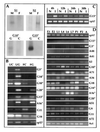Identification and characterization of differentially expressed cDNAs of the vector mosquito, Anopheles gambiae
- PMID: 8917545
- PMCID: PMC24047
- DOI: 10.1073/pnas.93.23.13066
Identification and characterization of differentially expressed cDNAs of the vector mosquito, Anopheles gambiae
Abstract
The isolation and study of Anopheles gambiae genes that are differentially expressed in development, notably in tissues associated with the maturation and transmission of the malaria parasite, is important for the elucidation of basic molecular mechanisms underlying vector-parasite interactions. We have used the differential display technique to screen for mRNAs specifically expressed in adult males, females, and midgut tissues of blood-fed and unfed females. We also screened for mRNAs specifically induced upon bacterial infection of larval stage mosquitoes. We have characterized 19 distinct cDNAs, most of which show developmentally regulated expression specificity during the mosquito life cycle. The most interesting are six new sequences that are midgut-specific in the adult, three of which are also modulated by blood-feeding. The gut-specific sequences encode a maltase, a V-ATPase subunit, a GTP binding protein, two different lectins, and a nontrypsin serine protease. The latter sequence is also induced in larvae subjected to bacterial challenge. With the exception of a mitochondrial DNA fragment, the other 18 sequences constitute expressed genomic sequence tags, 4 of which have been mapped cytogenetically.
Figures



References
-
- Warburg A, Miller L H. Parasitol Today. 1991;7:179–181. - PubMed
-
- Collins F H, Sakai R K, Vernick K D, Paskewitz S, Seeley D C, Miller L H, Collins W E, Campbell C C, Gwadz R W. Science. 1986;234:607–610. - PubMed
-
- Müller H-M, Catteruccia F, Vizioli J, della Torre A, Crisanti A. Exp Parasitol. 1996;81:371–385. - PubMed
-
- Collins F H. Parasitol Today. 1994;10:370–376. - PubMed
-
- Williams J G K, Hanafey M K, Rafalski J A, Tingey S V. Methods Enzymol. 1993;218:704–740. - PubMed
Publication types
MeSH terms
Substances
Associated data
- Actions
- Actions
- Actions
- Actions
- Actions
- Actions
- Actions
- Actions
- Actions
- Actions
- Actions
- Actions
- Actions
- Actions
- Actions
- Actions
- Actions
- Actions
- Actions
- Actions
LinkOut - more resources
Full Text Sources

